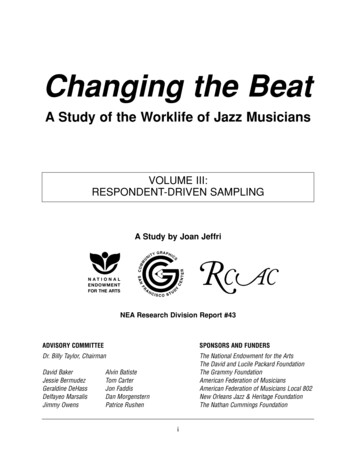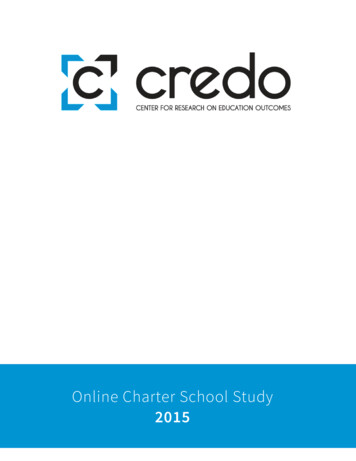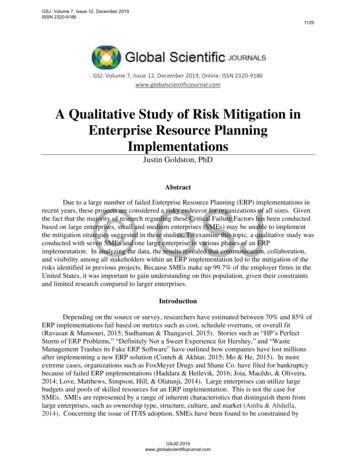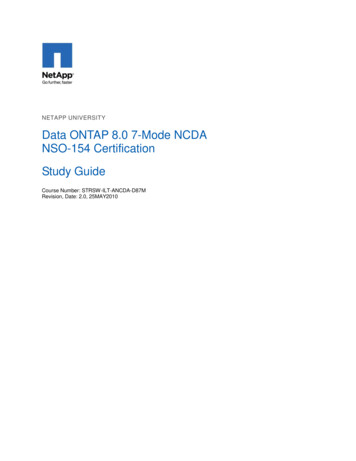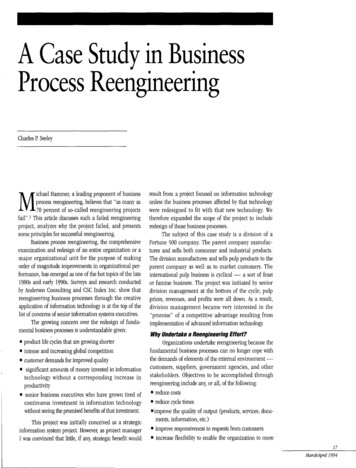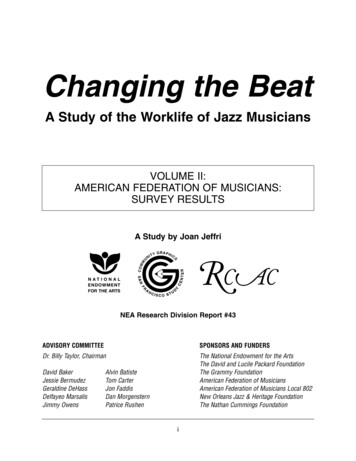
Transcription
Changing the BeatA Study of the Worklife of Jazz MusiciansVOLUME II:AMERICAN FEDERATION OF MUSICIANS:SURVEY RESULTSA Study by Joan JeffriNATIONALENDOWMENTFOR THE ARTSNEA Research Division Report #43ADVISORY COMMITTEESPONSORS AND FUNDERSDr. Billy Taylor, ChairmanThe National Endowment for the ArtsThe David and Lucile Packard FoundationThe Grammy FoundationAmerican Federation of MusiciansAmerican Federation of Musicians Local 802New Orleans Jazz & Heritage FoundationThe Nathan Cummings FoundationDavid BakerJessie BermudezGeraldine DeHassDelfayeo MarsalisJimmy OwensAlvin BatisteTom CarterJon FaddisDan MorgensternPatrice Rusheni
Project Director:Joan Jeffri, Director, Research Center for Arts and CultureTeachers College Columbia UniversityConsultants:Dr. Douglas Heckathorn, Cornell UniversityDr. Robert GreenblattProject coordinators:Adina WilliamsPhillip HarveyProject researchers:Judith HellmanJanine OkminData consultants:Oscar TorresJudith RosensteinCity Coordinators:DetroitDr. Bernard BrockDr. David MagidsonCenter for the Study of Art and Public PolicyWayne State UniversityNew OrleansPhilip Dobard, DirectorGraduate Program in Arts AdministrationUniversity of New OrleansNew YorkDr. Martin Mueller, DirectorJazz and Contemporary Music ProgramNew School UniversitySan FranciscoDr. Dee Spencer, Director of EducationSF Jazz OrganizationSan Francisco State UniversityLibrary of Congress info here from Executive SummaryCover:iiCopyright of Photo
Table of ContentsIntroductionPurposeFindingsSurvey Background and MethodOrganization of Report11223Chapter I. DemographicsChapter II. Employment and IncomeChapter III. Other IssuesChapter IV. Summary and Conclusions461432AppendicesA. Metropolitan Areas Used in the StudyB. Metropolitan Areas ContextC. Distribution of ResponsesD. Survey Advance LetterE. Response by Metro AreaF. Using the Capture-Recapture Method to Estimatethe Number of Jazz MusiciansG. Resource Directoryiii34354380818284
iv
IntroductionPurpose(AFM) and a Respondent-Driven Sampling (RDS)survey of jazz musicians. This volume focuses on theAFM survey of jazz musicians in four cities. Theresults of the RDS survey can be found in VolumeIII. Both it and the Executive Summary, Volume I,include results from three cities—New Orleans, NewYork and San Francisco.This study aims to support the continuing growthand development of jazz and the musicians who createit. Jazz musicians as a group, however, do notconstitute an easy subject for formal study. Indeed, fordecades it has been difficult simply to define the word“jazz” itself. “It cannot safely be categorized as folk,popular or art music,” states the New Grove Dictionaryof Jazz, “though it shares aspects of all three.” Thisstudy relied on the musicians themselves to indicatethat they played jazz music.To study jazz musicians, it is important tounderstand the idiosyncratic nature of the music. AsA.B. Spellman indicated in his introduction to theNEA publication, American Jazz Masters Fellowships1982-2002, jazz was “built on the discipline ofcollective improvisation which allowed formaximum expression of the individual within thecontext of the group.” The group, however, is oftenan ever-changing one. Unlike classical music, withorchestral members staying together for decades, oreven rock, where more often than not musiciansmake their music as a group, jazz musicians oftenlook for jams or gigs as individuals rather than aspart of a group. Indeed, a jazz group like theModern Jazz Quartet is remarkable for its longevityas much as its music.Working as an individual musician can be moretrying financially, in many ways, than working as agroup. This seems especially true in a musical formthat, while critically acclaimed as a national treasure,does not sell many tickets or CDs. In fact, jazzaccounts for only four percent of annual recordingsales in the United States. It can be even moredifficult for emerging jazz artists to make a livingwith their music; reissues of classic jazz recordingshave consistently outsold all but the most popularcontemporary jazz artists. Even that amount issomewhat inflated by the inclusion of pop artists inthe jazz category.Deemed a national treasure by the United StatesCongress, jazz is a unique American art form, and itsmusicians, the keepers and producers of thistreasure, are recognized the world over as America’scultural ambassadors. Yet, artists who make a livingas jazz musicians face numerous challenges. Despitehigh-profile projects and activities, such as Jazz atLincoln Center’s Essentially Ellington high schoolband competition, the Monterey and other jazzfestivals, or the Jazz documentary by Ken Burns, jazzmusic does not reach as vast an audience as othermusic forms, making it challenging to maintain andcontinue this treasure.Recognizing the importance of jazz and itsartists, the National Endowment for the Arts (NEA)in 2000 commissioned a study of jazz musicians infour U.S. metropolitan areas—Detroit, New Orleans,New York, and San Francisco. The statisticalinformation gathered in the study, will be used tohelp devise strategic ways to further the work of jazzartists. These four cities were chosen for theirgeographic diversity and their historical and currentrelationships with jazz. The NEA had two purposes: To understand the environment for jazz ineach of the study cities by documenting boththe jazz artists and their resources andsupport systems. To develop a detailed needs assessment fromjazz artists themselves by collecting datadocumenting their professional lives andmost pressing needs.This study provided an opportunity to examinethe working lives of jazz musicians in a systematicway and to produce quantitative and qualitativeinformation about the jazz community, theprofessional lives of jazz musicians, and jazz’s placein the music industry.Jazz musician and educator Dr. Billy Taylorformed and chaired an advisory board to guide theproject as it developed. The study also created afocus group of artists, managers, and educators, andnumerous jazz practitioners generously gave theirtime to help advise this project. The study wasconducted in two parts: a survey of musiciansbelonging to the American Federation of Musicians1
which jazz musicians operate. By presenting a clearerpicture of the working life of the jazz artist, thisstudy will help the NEA develop and fund programsthat address the concerns and challenges jazzmusicians face in creating and playing their music.Institutional support for jazz exists but is small.A few state and regional arts agencies and somenonprofit foundations offer grants to individualmusicians, but often at low amounts; in this study,of the musicians who received grants, more than 90percent received 5,000 or less. The Lila WallaceReaders Digest Fund and the Doris Duke CharitableFoundation have shored up institutions andendowments of jazz presenters, created networks inthe jazz community, and provided venues for jazzperformance. The National Endowment for the Artshas assisted these organizations with some of theirprograms—such as the joint program with the DorisDuke Charitable Foundation called JazzNet, whichfurthers jazz creation, presentation, and educationwith 14 regional jazz presenters. This programended in 1996, when Congress prohibited awardingdirect grants to individual artists, except for creativewriting and honorary awards in the folk andtraditional arts and jazz. The honorary award injazz, the American Jazz Masters Fellowship,specifically sponsors jazz musicians who areestablished and have achieved mastery of their art.Emerging artists have little access to such support.The data obtained through this study are crucialto a better understanding of the environment inSurvey Background and MethodIn an occupational sense, jazz musicians aredifficult to identify. While national-based surveyssuch as the Current Population Survey, conductedby the U.S. Census Bureau, are used to estimate thelabor force by occupation, the occupation categoriesare not detailed enough to distinguish jazzmusicians from the larger classification of arts,design, entertainment, and media occupations, oreven from the more specific category of musiciansand composers. In addition, the national-basedsurveys do not cover detailed questions or subjectsgermane to the study of jazz musicians.Given these shortcomings, the NationalEndowment for the Arts and the Research Center forArts and Culture partnered with the AmericanFederation of Musicians, AFM Local 802, the Davidand Lucile Packard Foundation, the GrammyFoundation, the American Federation of Musicians,the New Orleans Jazz & Heritage Foundation, andFindings The top instruments played by jazz musicians are piano/keyboard, trumpet and drums. 58.4 percent of the respondents earned their major income as musicians in the last 12 months and53 percent earned all their income from their music. On average, 43.9 percent of this income camefrom work as a jazz musician. For Detroit, only 35.3 percent came from jazz work and in NewOrleans, 57 percent. 36.3 percent have a college degree and another 28.7 percent have a graduate degree. 64.7 percent think they should be paid for people downloading their music on the Internet. 74.9 percent received music-related training in the city or region where they now reside. This ishighest in Detroit (80.3 percent). 89 percent have health coverage; this is highest in Detroit at 92.1 percent. Only 18 percent obtainedit from the musicians union, only 7.8 percent in Detroit. 63.1 percent have life insurance, a high of 80.3 percent in Detroit and a low of 52.3 percent in SanFrancisco. 77.3 percent have a retirement plan; 82.3 percent of San Francisco musicians have such a plan. 61.0 percent earned 40,000 or less as a musician in 2001. 7 percent earned over 100,000. 31.7 percent played over sixteen jobs a month and 40.7 percent play with more than four differentgroups. 84.1 percent are male; 71.9 percent are white.2
the Nathan Cummings Foundation to study andreport findings on jazz musicians. Since a nationalbased survey was beyond the means of the NEA andits partners, the study was restricted to fourmetropolitan areas1: Detroit, New Orleans, New Yorkand San Francisco.We selected a random sample of approximately15 percent of the membership of each local of theAmerican Federation of Musicians in each of themetropolitan areas under study. Since the uniondoes not distinguish between jazz and non-jazzmusicians, both types of members participated inthe survey. After sending an advance letter tellingmusicians about the survey, we administered a 68question telephone questionnaire on a total of 2,500musicians and received a 78.5 percent response(1,963).The union locals gave full participation to thisproject: Detroit (local 5), New Orleans (local 174496), New York (local 802), and San Francisco (local6). There is a long history of union involvementwith jazz musicians, not all of it easy. While unionparticipation in all professions is declining, themusicians’ locals are contemplating methods fortheir own survival. This is sometimes complicatedby the fact that union musicians in one city can joinanother union local (New York, for example) with ahigher established minimum wage and then quittheir original local.support systems (foundations, corporations,government) as well as the impact oftourism, festivals and heritage The mobility of jazz musicians who tour,both nationally and internationally The tendency of jazz musicians to play inmany different performance groups Four very different social and economicenvironments with very different responsibilities and resources of union locals, jazz-relatedfoundations, and community organizationsOrganization of ReportThe report is organized in four sections,presenting findings on demographics, income andemployment-related information, other issuesincluding professionalism, copyright, health andwelfare protection, musical styles and future goals ofjazz musicians, and a summary and conclusions.Appendices include definitions and contexts for eachmetro area studied, the distribution of responses bymetro area, the advance letter, the response by metroarea, an explanation of the method used to estimatethe number of jazz musicians and a directory ofresources for jazz musicians in each metro area.Since the union does not distinguish betweenjazz and non-jazz musicians, both were included inthe survey. The charts in this report show theaggregate results of all four cities combined, pluseach city’s results, separated into jazz and non-jazzmusicians.Jazz artists exist in a kind of no-man’s landwhere earning a living from jazz is almostimpossible, and where even individual support suchas the American Jazz Master Fellowship awards fromthe National Endowment for the Arts are not enoughto offset the hand-to-mouth existence of many jazzmusicians. Neither has jazz been the recipient ofsignificant philanthropic giving, although majorinitiatives by the Lila Wallace-Readers Digest Fundand the Doris Duke Charitable Foundation arehappy exceptions. These programs have shored upinstitutions and endowments of jazz presenters,created networks in the jazz community, andprovided money for more venues, performances andjazz compositions.CharacteristicsSome characteristics of the larger jazzcommunity made the isolation of four citiesparticularly important since they represent differentgeographic sections of the country, histories for jazzmusicians, levels of resources for jazz musicians, racialand ethnic balances, and social and economicenvironments. By studying jazz artists in such diverselocations, we hope to represent more accurately therange of situations for U.S. jazz musicians. The diversity in styles of jazz — musiciansoften play to different audiences, venues, andmedia with different levels of exposure Commercial (record companies andrecordings, venues, radio, television andtechnology in jazz vs. non-commercial1See Appendix A for definitions and background descriptions of the metropolitan areas used and Appendix B for a context ofeach of the cities.3
Chapter I. Demographics*Age, Gender, Marital StatusEighty-four percent of the jazz musicianswho are members of the American Federation ofMusicians are male, 72 percent are white, andtheir networks consist primarily of other whitejazz musicians, followed by African-Americanjazz artists.Eighty-four percent of jazz musicians are maleand 16 percent are female; 53 percent of non-jazzmusicians are male and 47 percent are female. Themean age for jazz musicians is 53; the median is 50.For non-jazz musicians the mean age is 50 and themedian 47. These ages are somewhat older thanthose for other union performers we have studied.Almost three quarters of the respondents are white(72 percent jazz and 85 percent non-jazz), 18percent jazz and 5 percent non-jazz are AfricanAmerican and about 2 percent jazz and 1 percentnon-jazz are Hispanic or Latino.The age range for jazz musicians was from 16 to92; the age of non-jazz musicians ranged from 23-90.It is also interesting to note that almost half therespondents (46 percent jazz and 50 percent nonjazz) claim only themselves as dependents withanother 29 percent jazz and 26 percent non-jazzclaiming two dependents.Twenty percent of jazz and 23 percent non-jazzmusicians are single; 62 percent (jazz) and 60percent (non-jazz) are married.EducationTwenty-three percent of jazz and 12 percent ofnon-jazz respondents have some college; 36 percentof jazz and 37 percent of non-jazz musicians have acollege degree and an additional 29 percent of jazzand 43 percent of non-jazz musicians have agraduate degree. In 1997 in the Research Center’sInformation on Artists study, union actors in tenU.S. cities were among the artists studied. Of theAEA actors who responded: 18 percent had some college 45 percent had a college degree 29 percent had a graduate degree.Please indicate your highest level of formal educationTotalelementary school, throughgrade 8PercentNumbersome high schoolPercentNumber12th grade, but did notgraduatePercent12th grade, got GEDPercentNumberNumber12th grade, graduated fromhigh schoolPercentNumbersome collegePercentNumberNewNew YorkSanOrleansFranciscoJazz Non Jazz Non Jazz Non Jazz Non Jazz NonJazzJazzJazzJazzJazz0.3% 0.5% 0.0% 1.2% 0.0% 0.0% 0.5% 0.5% 0.0% 0.0%4Detroit2010041001.2% 0.7% 2.0% 1.2% 2.4% 2.8% 0.5% 0.5% 1.3% 0.0%193616141300.9% 0.5% 1.0% 0.0% 1.2% 0.0% 0.8% 0.5% 0.4% 0.9%132303061110.6% 0.2% 0.7% 1.2% 0.4% 0.0% 0.7% 0.0% 0.4% 0.0%91211050106.9% 3.7% 8.5% 3.5% 8.1% 5.6% 6.5% 3.6% 4.6% 3.6%1051626320248711422.6% 11.5% 29.5% 9.4% 25.0% 16.7% 19.8% 10.7% 19.8% 12.6%34649908626147214714* The confidence level for this survey is 95 percent with a 5 percent margin of error. Figures do not necessarily add up to 100percent due to multiple answers and don’t know/refused. In the New Orleans metro area, the majority of respondents residedin Orleans Parish; in Detroit in Wayne and Oakland Counties; in San Francisco, San Francisco and Alameda counties, followedby San Mateo, Contra Costa and San Mateo Counties; and in the New York Metro area, New York County (includesManhattan) and Kings County (includes Brooklyn). (See Appendix).4
college degreePercentgraduate total # of respondents whoanswered this question36.3% 37.4% 27.9% 34.1% 33.1% 33.3% 39.0% 39.3% 42.2% 37.8%55616085298212289771004228.7% 43.2% 26.9% 49.4% 26.2% 41.7% 30.7% 43.4% 27.0% 38.7%439185824265152288564432.5% 2.3% 3.3% 0.0% 3.6% 0.0% 1.4% 1.5% 3.8% 6237111While the number of union musicians that have college degrees is about 10 percent lower than for unionactors, 28.7 percent of union jazz musicians, like union actors, and 43.2 percent of union non-jazz musicianshave graduate degrees.Twenty-six percent of both kinds of musicianshad conservatory or professional school trainingwhich did not grant a degree and 79 percent of jazzand 78 percent of non-jazz musicians studied withprivate teachers.Did you receive technical or professional training in the arts?TotalnoPercentNumberconservatory or professionalschool not granting a degreePercentNumbercertificate program in the arts PercentNumberprivate teachersPercentother (please specify)PercentNumberNumberNewNew YorkSanOrleansFranciscoJazz Non Jazz Non Jazz Non Jazz Non Jazz NonJazzJazzJazzJazzJazz21.9% 23.8% 23.9% 22.4% 30.2% 19.4% 18.9% 25.0% 20.3% 24.3%336Detroit102731975714049482725.7% 26.4% 25.9% 16.7% 24.3% 27.6% 25.8% 25.2% 26.5% 35.7%30786601142815537503011.5% 12.0% 10.8% 18.2% 14.5% 10.3% 11.0% 10.2% 11.1% 10.7%137392512253661521978.9% 78.2% 77.6% 72.7% 79.2% 82.8% 79.2% 83.0% 78.8% 72.6%94325518048137244771221496115.1% 13.2% 17.2% 12.1% 20.2% 13.8% 13.1% 11.6% 14.3% 16.7%18143total # of respondents whoanswered this question540835479172714
Chapter II.Employment and Income-Related FindingsEmploymentmusic business; 36 percent jazz) and 23 percent(non-jazz) respectively are employed as full-timefreelancers in the music business and 22 percent(jazz) and 28 percent (non-jazz) as part-timefreelancers in the music business. No one isunemployed and 14 percent (jazz) and 9 percent(non-jazz) are retired.Thirty-two percent of jazz and 20 percent ofnon-jazz respondents play more than 16 differentmusical jobs per month.Fifty-eight percent of the jazz musicianrespondents earned their major income in the last12 months as musicians, 12 percent in non-musicrelated occupations and another 10 percent as musicteachers and 1 percent as jazz teachers. Fifty-sevenpercent of the non-jazz musicians earned theirmajor income in the last 12 months as musicians, 11percent in non-music related occupations, 12percent as music teachers.IncomeJust over half of the union musicians earnedtheir major income in the last 12 months asmusicians. Forty-three percent of jazz and 48percent of non-jazz musicians are employedfull-time in the music business. And no one isunemp
NEA publication,American Jazz Masters Fellowships 1982-2002, jazz was “built on the discipline of collective improvisation which allowed for maximum expression of the individual within the context of the group.” The group, however, is often an ever-changing one. Unlike classical music,
